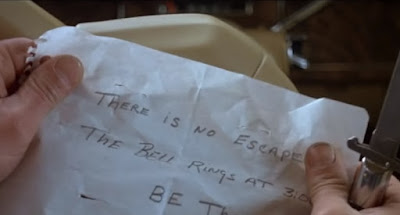They Live by Night (1948) Director Nicholas Ray’s debut feature
is a gripping film noir about doomed love between Bowie (Farley Granger), an
escaped convict, and Keechie (Cathy O'Donnell), an inexperienced young woman
who wants to escape her father (Will Wright) and her humdrum life. Granger is
excellent as the conflicted Bowie, who’s torn between his new marriage and allegiance
to his former cellmates (Howard Da Silva and Jay C. Flippen). O’Donnell is the
film’s true revelation, however, appearing as if she’s never experienced a day
of happiness. After a final bank heist goes wrong, they’re on the run from
authorities. Ray keeps the focus on the two leads, rather than Bowie’s criminal
activities, keeping the movie from becoming a standard cops-and-robbers drama.
We want the star-crossed lovers to succeed, despite the odds against them,
which only makes everything more tragic.
Rating: 4 stars.
Available on Blu-ray and DVD
Fear in the Night (1972)
This nifty Hammer thriller from director/co-writer Jimmy Sangster is filled
with suspense and surprises that will keep you guessing until the end. After experiencing
a nervous breakdown, young teacher Peggy Heller (Judy Geeson) moves with her
new husband Robert (Ralph Bates) to the country (where he works at a boarding
school) for some peace and quiet. She soon finds that her troubles follow her,
as she suffers attacks from a mysterious figure with an artificial arm. Unfortunately
for Peggy, everyone around her, including Robert, believes the incidents are in
her head (or are they?). The suspects continue to add up, including Robert’s employer,
the eccentric headmaster Carmichael (Peter Cushing) and his antagonistic
younger wife Molly (played by Joan Collins, doing what she does best). Sangster
does a nice job planting the seed of doubt about Peggy’s sanity in the audience’s
mind.
Rating: 3 ½ stars. Available on Blu-ray and DVD
Prophecy (1979) John
Frankenheimer’s environmental horror is a monster movie with a social
conscience. A doctor (Robert Foxworth) is hired by a lumber company to smooth
things over with a Native American tribe living in the Maine wilderness. Something
is out there killing people, and the company officials point fingers at the
tribe. The tribe members, however, led by John Hawks (Armand Assante) know there’s
something else responsible, a terrible creature that could be the incarnation
of a vengeful god.
Despite some missteps (some laughable mutant bear creature
effects and the questionable casting of Armand Assante as a Native American), Prophecy
has a lot to like. It’s more thoughtful than the usual nature on rampage flick,
with its strong anti-pollution message, and sympathetic leanings toward disenfranchised
members of society. It’s too bad that the story ultimately leaves us hanging
about the fate of the people in the tribe, in favor of the two leads (Foxworth
and Talia Shire, as his pregnant wife), but it’s an entertaining ride.
Rating: 3 stars. Available on Blu-ray, DVD and Amazon Prime
The Box (2009) Writer/director Richard Kelly (Donnie
Darko) tries his hand at adapting the short story “Button, Button” by
Richard Matheson, with mixed results. Cameron Diaz and James Marsden play Norma
and Arthur Lewis, a married couple presented with a strange dilemma. They’re given
a box with a button – by pressing it, someone they don’t know will die, but in
turn they will be awarded $1 million. Frank Langella does a nice job as the
enigmatic Arlington Steward, who explains the rules of the box to the confused
couple. The intriguing premise is stretched to the breaking point, expanded as
a two-hour movie. It’s a perfect concept for an anthology film or series (it
was adapted for the ‘80s revival of The Twilight Zone), but needless exposition
and an alternate dimension/alien subplot do little to justify the bloated
running time.
Rating: 2 ½ stars.
Available on Blu-ray, DVD and Netflix














